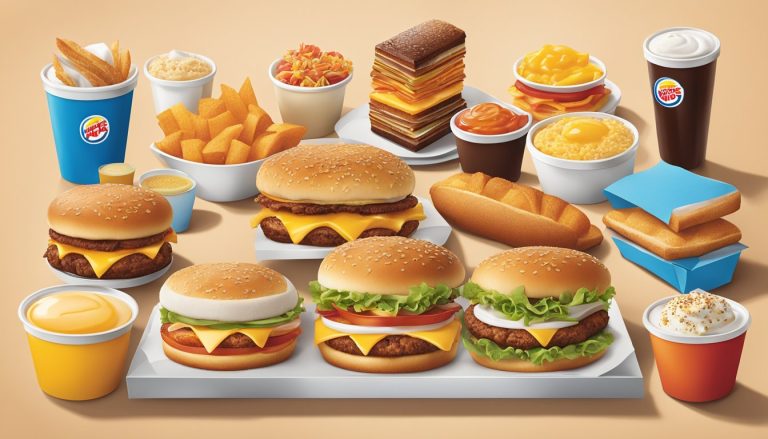Color plays a crucial role in shaping consumer perceptions and behaviors. BK’s Breakfast Branding leverages color psychology to create a memorable and appealing visual identity. The strategic use of warm, energetic hues in BK’s breakfast branding evokes feelings of comfort, excitement, and appetite stimulation.
The color palette chosen for BK’s breakfast offerings typically includes shades of yellow, orange, and red. These colors are associated with warmth, energy, and excitement – perfect for enticing sleepy customers to start their day with a hearty meal. Yellow, in particular, is linked to cheerfulness and optimism, setting a positive tone for the morning.
BK’s branding team carefully selects and applies these colors across various touchpoints, from packaging to in-store displays and digital advertisements. This consistent use of color helps reinforce brand recognition and creates a cohesive visual experience for customers. By tapping into the psychological impact of colors, BK aims to create an inviting and appetizing atmosphere that encourages breakfast sales.
Understanding Color Psychology
Color psychology explores how different hues impact human emotions and behaviors. This field offers insights into leveraging colors for effective branding and marketing strategies.
Basics of Color Psychology
Color psychology stems from color theory principles. Primary colors – red, blue, and yellow – form the foundation. Secondary colors emerge from mixing primaries: green, orange, and purple. Tertiary colors result from combining primary and secondary hues.
Colors evoke specific psychological responses. Warm colors like red and orange tend to energize, while cool tones like blue and green often calm. Understanding these effects helps brands choose palettes that align with their desired image and audience reactions.
The context of color use also matters. A color’s impact can vary based on its surrounding hues and the overall design composition.
Emotional Associations of Colors
Different colors trigger distinct emotional responses. Red often signifies excitement or passion. Blue conveys trust and stability. Yellow radiates happiness and optimism.
Green is associated with nature and growth. Purple suggests luxury or creativity. Orange combines the energy of red with the cheerfulness of yellow.
White represents purity and cleanliness. Black can signify sophistication or mystery. Brown evokes a sense of reliability and comfort.
These associations play a crucial role in branding. Companies select colors that align with their brand personality and target audience preferences.
Cultural Differences in Color Perception
Color interpretations vary across cultures. In Western cultures, white often symbolizes purity and weddings. In some Eastern cultures, it’s associated with mourning.
Red signifies luck and prosperity in China but can represent danger in other regions. Purple is linked to royalty in many Western countries but to mourning in some Latin American cultures.
Green is sacred in Islam but can symbolize infidelity in some Western contexts. Yellow is considered imperial in China but can signify cowardice in some Western interpretations.
Understanding these cultural nuances is crucial for global branding strategies. Colors that resonate positively in one market might have negative connotations in another.
The Role of Color in Branding
Color plays a crucial role in shaping brand identity, conveying personality, and maintaining consistency across marketing materials. It serves as a powerful tool for creating emotional connections with consumers and influencing their perceptions of a brand.
Creating Brand Identity Through Color
Colors are fundamental in establishing a unique brand identity. They help companies stand out from competitors and become instantly recognizable. Red and yellow, for instance, are closely associated with McDonald’s, while Coca-Cola’s distinctive red is a key part of its visual identity.
Brand colors can evoke specific emotions and associations. Blue often signifies trust and reliability, making it popular among financial institutions. Green is frequently used by eco-friendly brands to emphasize sustainability.
A well-chosen color palette can communicate a brand’s values and positioning without words. This visual shorthand allows consumers to quickly grasp a company’s essence and remember it more easily.
Color Choices and Brand Personality
The selection of brand colors significantly impacts how a company is perceived. Bright, vibrant hues may convey energy and youthfulness, while muted tones can suggest sophistication or luxury.
Color choices should align with a brand’s target audience and industry norms. A children’s toy brand might opt for playful primary colors, while a high-end jewelry company may lean towards elegant metallics.
Cultural associations with colors must be considered for global brands. White symbolizes purity in Western cultures but can represent mourning in some Eastern countries.
Consistency in Brand Colors
Maintaining color consistency across all brand touchpoints is essential for building recognition and trust. This includes everything from logos and packaging to websites and social media profiles.
A brand style guide typically outlines specific color codes (HEX, RGB, CMYK) to ensure accurate reproduction across different mediums. This consistency reinforces brand identity and makes marketing efforts more cohesive.
Consistent use of brand colors helps create a unified experience for customers, whether they’re interacting with the brand online, in print, or in physical stores. It strengthens brand recall and fosters a sense of familiarity and reliability.
Impact of Colors on Marketing and Advertising
Colors play a crucial role in shaping consumer perceptions and influencing purchasing behaviors. They serve as powerful tools in marketing campaigns and can evoke specific emotional responses from target audiences.
Influence of Color on Purchasing Decisions
Color choices significantly affect consumer decision-making processes. Studies show that up to 90% of initial product assessments are based on color alone.
Red often creates a sense of urgency, making it effective for clearance sales. Blue inspires trust and security, commonly used by financial institutions. Green is associated with health and nature, popular in eco-friendly product marketing.
Colors can also impact perceived value. Luxury brands often use black, gold, and silver to convey sophistication and premium quality. Budget-friendly options may opt for brighter, more approachable colors like orange or yellow.
Color in Marketing Campaigns and Strategies
Marketers strategically employ color psychology to reinforce brand identity and messaging. Consistent color use across marketing materials helps build brand recognition and recall.
Some companies use color to differentiate product lines. For example, a beverage company might use blue for low-calorie options and red for regular versions. This visual shorthand aids consumers in quickly identifying desired products.
Seasonal color trends also influence marketing strategies. Brands may adjust their color palettes to align with holidays or seasons, creating timely and relevant campaigns that resonate with consumers.
Psychological Effects and Emotional Response
Colors evoke specific emotions and associations, which marketers leverage to create desired brand perceptions. Warm colors like red and orange can stimulate appetite, making them popular choices for food-related brands.
Cool colors such as blue and green often elicit feelings of calmness and trust. This makes them effective for healthcare and financial services marketing. Purple is associated with creativity and luxury, frequently used in beauty and high-end product advertising.
Color combinations can also influence emotional responses. Complementary color schemes may create visual interest and excitement, while monochromatic palettes can convey elegance and simplicity. Understanding these effects allows marketers to craft visually appealing and emotionally impactful campaigns.
Color and Consumer Behavior
Color choices in branding significantly influence consumer perceptions and behaviors. Strategic use of color can shape brand associations and evoke specific emotional responses from customers.
Color Perceptions and Brand Association
Colors play a crucial role in how consumers perceive and remember brands. Red, often used in fast food branding, can stimulate appetite and create a sense of urgency. Blue tends to evoke feelings of trust and reliability, making it popular for financial institutions. Yellow captures attention and is associated with optimism, while green often represents health and nature.
Brand recognition can increase by up to 80% through consistent color use across marketing materials. This highlights the importance of selecting appropriate colors that align with a brand’s personality and values. Companies like Coca-Cola have successfully leveraged color psychology, with their iconic red branding evoking excitement and energy.
Emotional Connections with Consumers
Colors have the power to elicit emotional responses and influence purchasing decisions. Warm colors like red and orange can create a sense of excitement or impulse, potentially leading to quicker decision-making. Cool colors such as blue and green may promote feelings of calmness and trust, encouraging thoughtful consideration.
Research shows that up to 90% of snap judgments about products can be based on color alone. This emphasizes the need for brands to choose colors that resonate with their target audience’s preferences and cultural associations. For example, purple is often linked with luxury and creativity, making it a popular choice for beauty and artistic brands.
Effective use of color in branding can:
- Increase brand recognition
- Evoke specific emotions
- Influence purchasing behavior
- Differentiate from competitors
By understanding color psychology, brands can create stronger emotional connections with consumers and enhance their overall marketing effectiveness.
Specific Color Meanings in Branding
Colors play a crucial role in shaping brand perceptions and eliciting emotional responses from consumers. Different hues can evoke distinct feelings and associations, influencing how people interact with and remember brands.
Trust and Security: Blue
Blue is widely recognized as a color that inspires trust and security. Many financial institutions and technology companies use blue in their branding to convey reliability and professionalism.
The calming nature of blue helps create a sense of stability and dependability. It’s often associated with clear skies and open waters, evoking feelings of tranquility and confidence.
Banks frequently incorporate blue into their logos and marketing materials to reassure customers about the safety of their money. Social media platforms also leverage blue to foster a sense of community and trustworthiness among users.
Excitement and Energy: Red and Orange
Red and orange are vibrant colors that can spark excitement and energy in branding. These warm hues are often used by companies wanting to create a sense of urgency or passion around their products.
Red is associated with strong emotions like love and anger. It can increase heart rate and create a feeling of immediacy. Fast food chains often use red to stimulate appetite and encourage quick decision-making.
Orange combines the energy of red with the cheerfulness of yellow. It’s seen as friendly, confident, and adventurous. Brands targeting young, enthusiastic audiences frequently incorporate orange to convey a sense of fun and affordability.
Health and Positivity: Green and Yellow
Green and yellow are colors that evoke feelings of health, growth, and positivity in branding. These hues are popular choices for companies promoting wellness, natural products, or environmental initiatives.
Green is strongly associated with nature, renewal, and balance. It’s often used by eco-friendly brands to highlight their commitment to sustainability. Health food companies and organic product lines frequently incorporate green to emphasize freshness and vitality.
Yellow is linked to sunshine, happiness, and optimism. It’s an attention-grabbing color that can create a sense of warmth and cheerfulness. Brands aiming to appear youthful and accessible often use yellow to create a welcoming atmosphere.
Luxury and Creativity: Purple
Purple has long been associated with royalty, luxury, and creativity in branding. It’s a complex color that combines the stability of blue with the energy of red, creating a sense of mystery and sophistication.
High-end brands often use purple to convey exclusivity and premium quality. It’s particularly popular in the beauty and cosmetics industry, where it suggests indulgence and pampering.
Purple is also linked to creativity and imagination. Tech companies and educational brands may use purple to highlight innovation and forward-thinking approaches. The color can evoke feelings of wisdom and respect, making it suitable for brands targeting discerning consumers.
Case Studies in Color Branding
Color choices profoundly impact brand perception and consumer behavior. Examining successful companies reveals how strategic use of color psychology strengthens brand identity and emotional connections.
Coca-Cola and the Power of Red
Coca-Cola’s iconic red branding exemplifies effective color psychology in marketing. The vibrant red hue evokes excitement, energy, and passion. This color choice aligns perfectly with Coca-Cola’s brand identity as a refreshing, energizing beverage.
Red also increases heart rate and stimulates appetite, making it an ideal choice for a food and beverage company. Coca-Cola’s consistent use of red across all marketing materials has solidified its brand recognition globally.
The company’s “Share a Coke” campaign further leveraged the power of red, combining it with personalized white labels. This contrast made the product stand out on shelves and in advertisements.
The Green in Starbucks’ Brand Experience
Starbucks’ use of green in its branding demonstrates how color can shape a company’s entire brand experience. The green color palette evokes feelings of nature, growth, and harmony.
This color choice reflects Starbucks’ commitment to sustainability and ethical sourcing. It also creates a sense of calm and relaxation, encouraging customers to linger in their stores.
Starbucks uses various shades of green throughout its branding, from the logo to store interiors. This consistency reinforces brand recognition and creates a cohesive customer experience across all touchpoints.
The company’s green branding extends to its product packaging, creating a distinctive presence on retail shelves. This visual consistency has helped Starbucks build a strong, recognizable brand identity worldwide.
Brand Recognition and Trustworthiness

Color choices in Burger King’s breakfast branding play a pivotal role in shaping customer perceptions and fostering trust. Strategic use of colors enhances brand recognition and conveys reliability.
First Impressions and Visual Identity
Burger King’s breakfast branding relies on warm, inviting colors to create positive first impressions. Orange and yellow hues dominate, evoking feelings of energy and optimism. These colors align with the morning meal concept, signaling a fresh start to the day.
The brand’s visual identity incorporates familiar logo elements, ensuring instant recognition. Bold, contrasting colors make menu items stand out, catching customers’ attention quickly. This color strategy helps Burger King differentiate its breakfast offerings from competitors.
Building Trust Through Color Branding
Consistent color use across Burger King’s breakfast materials builds customer trust. The brand employs a palette that includes touches of blue, a color associated with dependability and professionalism.
This color combination reassures customers about food quality and service reliability. By maintaining color consistency in packaging, advertising, and in-store displays, Burger King reinforces its commitment to delivering a trustworthy breakfast experience.
Strategic color choices also help communicate nutritional information clearly, further enhancing customer trust in the brand’s transparency and dedication to their well-being.
Developing Effective Branding Strategies

Crafting a successful branding strategy requires careful color selection, consistent visual elements, and a balance between industry standards and innovative approaches. These factors work together to create a memorable and impactful brand identity.
Selecting the Right Color Palette
Choosing the appropriate colors for a brand is crucial. Start by identifying the brand’s core values and target audience. Research color psychology to understand how different hues evoke specific emotions and associations.
Consider using a primary color that aligns with the brand’s personality. For example, BK’s use of blue in their breakfast branding conveys trust and reliability. Select 1-3 complementary colors to create a harmonious palette.
Test color combinations in various contexts, such as packaging, signage, and digital platforms. Ensure the chosen palette remains visible and appealing across different mediums and lighting conditions.
Maintaining Visual Consistency
Consistency in color usage strengthens brand recognition. Develop a comprehensive style guide that outlines specific color codes (RGB, CMYK, Pantone) for all brand elements.
Apply the color palette consistently across all touchpoints:
- Logo
- Packaging
- Website
- Social media
- Advertising materials
- In-store displays
Regular audits of brand materials help maintain color consistency. Train staff and partners on proper color usage to ensure uniform application across all brand representations.
Evaluating Industry Norms and Innovations
Analyze competitor color schemes and industry trends to inform branding decisions. While conforming to certain norms can aid recognition, strategic deviation can help a brand stand out.
Consider color trends in the food industry, particularly for breakfast items. Warm, appetizing colors like reds and yellows are common, but unique combinations can create differentiation.
Explore innovative color applications, such as color-changing packaging or interactive digital color experiences. These can engage customers and create memorable brand interactions.
Test new color strategies on a small scale before full implementation. Gather customer feedback to gauge the effectiveness of color innovations in enhancing brand perception and recall.
Conclusion

BK’s breakfast branding leverages color psychology to create a powerful impact. The carefully chosen palette evokes warmth, energy, and appetite appeal.
Brand colors play a crucial role in shaping consumer perception. BK’s use of reds and yellows stimulates excitement and hunger, while browns convey comfort and reliability.
Consistent messaging through color reinforces BK’s brand identity across platforms. This cohesive approach builds trust and recognition among customers.
The strategic color choices contribute to a positive brand image. Warm hues associated with morning sunlight align perfectly with breakfast offerings.
Emotional connections are forged through familiar color associations. BK’s palette taps into feelings of comfort and satisfaction linked to hearty morning meals.
By understanding and applying color psychology principles, BK has crafted a breakfast brand identity that resonates with consumers on multiple levels. This approach enhances the overall dining experience and strengthens BK’s position in the competitive breakfast market.




